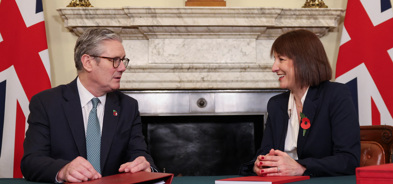Inflation: from flickering to forceful
After a decade when inflationary pressures have barely flickered, investors are now being forced to consider the impact of materially higher inflation on their portfolios. As global stimulus combines with economic recovery to push prices higher, investors are now debating whether the effect will be transitory or persistent. This may prove to be one of the most important issues for the year ahead.
The value of investments can fall as well as rise and that you may not get back the amount you originally invested.
Nothing in these briefings is intended to constitute advice or a recommendation and you should not take any investment decision based on their content.
Any opinions expressed may change or have already changed.
Written by Ben Seager-Scott
Published on 21 May 20215 minute read

What’s happened with inflation?
Since the financial crisis, inflation has been a sideshow. Economies have more often been battling with deflationary forces: China’s manufacturing might has depressed consumer prices across the world, while shrinking working age populations have kept growth lower across developed markets. Technology has brought down production costs, while globalisation has allowed companies to access low-cost labour.
The immediate causes of the current inflationary panic are largely a result of the pandemic. Policymakers have put in place coordinated fiscal and monetary stimulus that, when combined with economic recovery, could trigger inflation. Consumers have amassed savings and stimulus cheques that, when freed from lockdown, they will want to spend.
At the same time, production difficulties have created supply bottlenecks. This is affecting commodities and key components such as semiconductors. This is pushing up input prices for companies. In their first quarter results, companies increasingly complained of rising costs and warned they would need to raise prices (1.)
Real-world inflation figures are increasingly reflecting this. In the US, April data showed consumer prices rising at 4.2% year on year (2.), well ahead of expectations. As it stands, higher inflation has not yet been seen in the UK and Europe, where recovery is less established and stimulus packages less generous.
Should investors be worried?
The worry today is not that inflation figures spike higher in the months ahead: investors are steeled for higher inflation prints as economies unlock. The worry is that inflation persists beyond these few early months of recovery. The Federal Reserve is untroubled, with officials dismissing rising prices as a ‘transitory’ surge. (2.)
The case for inflation being ‘short-lived’
On the one hand, there are arguments to suggest inflation may be short-lived. While stimulus packages are vast and unprecedented, some economists have argued that the measures are not really a ‘stimulus’ as such, because they are simply substituting economic activity that had been closed down by the State. Equally, the Federal Reserve’s stimulus is front-loaded and effects may start to fade as early as 2022. Governments may be strategic, paring back spending should self-sustaining recovery emerge.
While loose monetary policy is likely to persist, monetary policy alone generally has little direct impact on the real economy or consumer goods prices – it tends to become stuck in the financial system. Plus, some deflationary forces remain firmly in place: technology innovation persists, for example, and any resurgence in wage inflation looks some way off.
The case for concern around inflation
These are sound arguments, but we are inclined to the view that inflation is a concern. Policymakers are incentivised to encourage inflation. Central banks have developed a credibility gap, having failed to hit their inflation target for an extended period of time. The language they are using – the ‘symmetrical’ nature of the inflation target, targeting ‘average inflation’ – is indicative of a new willingness to let inflation run a little higher.
Equally, monetary stimulus is now combined with fiscal stimulus. Fiscal stimulus tends to have a greater impact on real economic activity and inflation. Governments could pare back stimulus, but their weary electorates may not thank them for it. They are also well-aware that inflation would erode the real value of their debt pile.
Drivers for inflation
There are other drivers for inflation. Household saving rates have spiked: the household savings ratio increased from 9.6% in the first quarter of 2020 to 29.1% in the second, a record high since the series began in 1987. Deposits in bank accounts increased by £44.6 billion. (3.). This ‘enforced saving’ has continued through the pandemic, with consumers unable to spend money on restaurants, the cinema, holidays or other leisure activities. However, online spending has been buoyant, suggesting confidence remains high. We believe some of these pent-up savings will find their way back into the economy as shops and leisure activities re-open.
There are also longer-term considerations. China is pursuing more isolationist policies, while both the US/China trade war and the pandemic have shown the potential vulnerabilities in lengthy supply chains. This has prompted a wave of ‘re-shoring’ as companies focus on supply chain resilience rather than efficiency. Inevitably, this will inflate costs for companies, who can no longer roam the world to look for the lowest cost of production.
Our thinking: mindful not fearful
We are focusing on forward-looking inflation expectations. Headline CPI numbers will inevitably rise due to low comparative figures and other one-off factors. They should fall back in the latter part of 2021. This final number is more important, reflecting the market’s medium term expectation on inflation.
There are a number of steps that can be taken to reflect inflation expectations across Ready-made Portfolios. Depending on the mandate, we have generally been favouring a significant reduction in nominal government bonds, substituting inflation-linked securities and corporate bonds. We are generally seeking to keep interest rate sensitivity (duration) low and where risk allows, holding a little more in equites or alternative asset classes.
Despite rhetoric to the contrary, we believe central banks will be forced to take some action against higher inflation, meaning they could well look to reduce their quantitative easing programmes towards the end of the year, before gently starting to hike rates in the next two years. Even if they fall a little behind the curve, we don’t expect them to lose control.
Our central view is for CPI inflation of around 2-3% over the medium-term. This wouldn’t necessitate dramatic tightening so as to choke off economic growth. Of course, tail risks persist and we continue to monitor these closely. To our mind, investors need to be mindful but not fearful on inflation. We are keeping a close watch and are poised to take action should inflationary pressures grow more persistent.
Get in touch
If you want to speak to us about your investments or have any questions about this article, speak to us by calling 020 7189 2400.
This article should not be construed as investment advice. Our opinions may change without notice.
- Financial Times, May 2021
- Financial Times, May 2021
- House of Commons Library, January 2021
Get insights and events via email
Receive the latest updates straight to your inbox.
You may also like…


Market news
2024 Autumn Budget Overview: The key announcements from Chancellor Rachel Reeves




